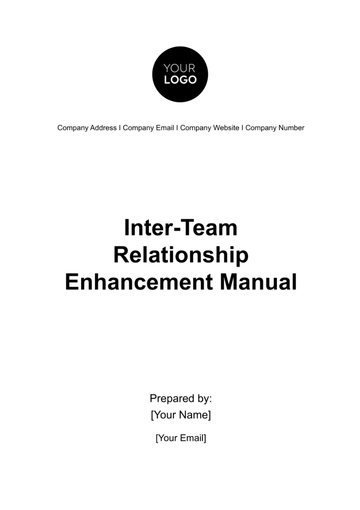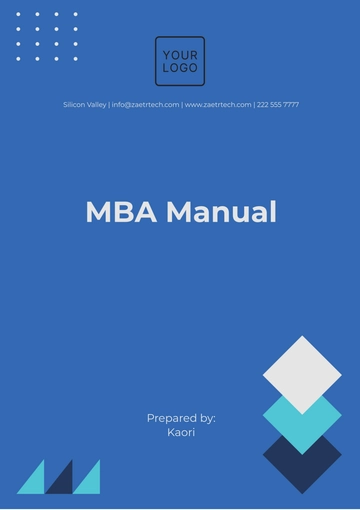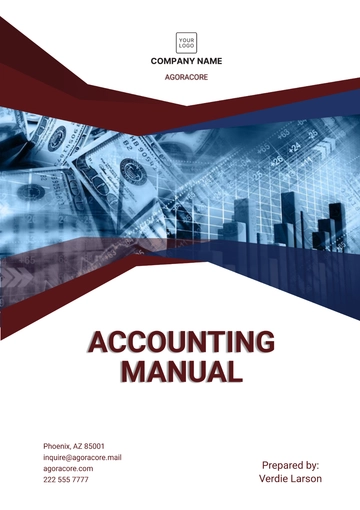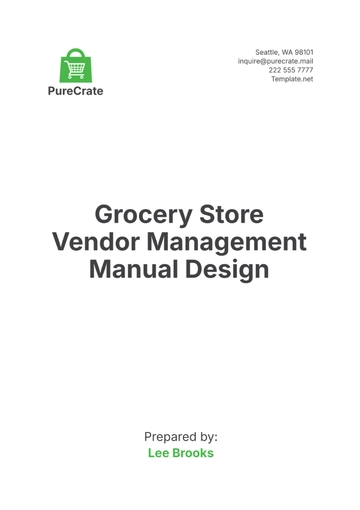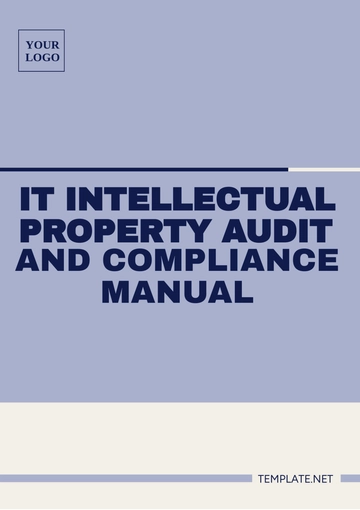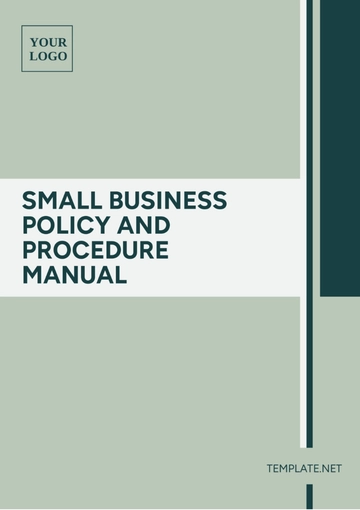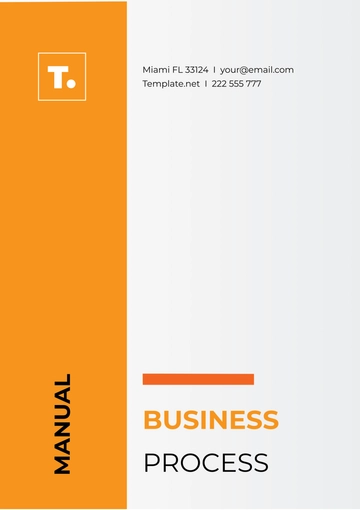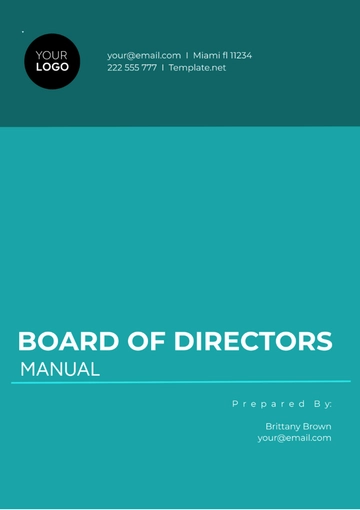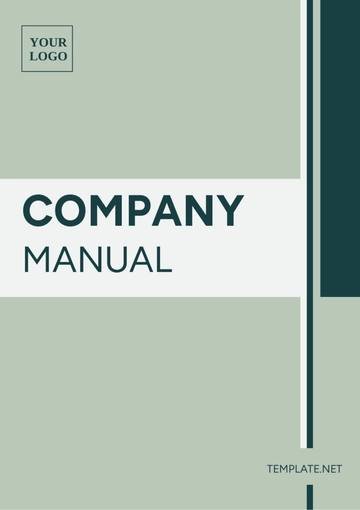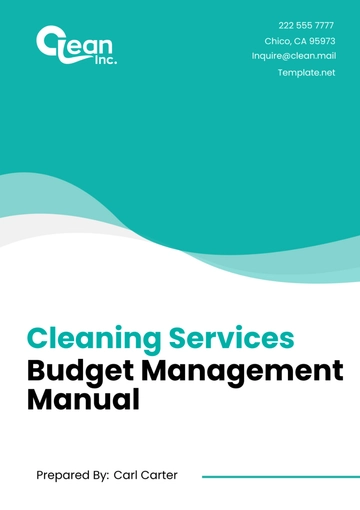Free Agriculture Financial Strategy Manual

I. Introduction
A. Purpose
The purpose of this Agriculture Financial Strategy Manual is to provide a comprehensive guide for managing the financial aspects of [Your Company Name]. This manual outlines the processes and strategies necessary to ensure financial stability, growth, and sustainability in the agriculture sector.
B. Scope
This manual covers all financial management aspects, including budgeting, financial planning, investment strategies, risk management, and financial reporting. It is intended to be a comprehensive resource for all stakeholders involved in the financial operations of [Your Company Name].
C. Target Audience
The target audience for this manual includes financial managers, accountants, auditors, investors, and other stakeholders involved in the financial decision-making process at [Your Company Name].
II. Financial Planning and Budgeting
A. Budget Preparation
Annual Budget Development: Create a detailed annual budget outlining expected revenues and expenses for the upcoming year. This budget should be based on historical data, market trends, and strategic goals.
Departmental Budgets: Develop individual budgets for each department to ensure accurate allocation of resources and accountability. Departments should submit their budget proposals for review and approval.
Capital Expenditure Planning: Identify and plan for major capital expenditures, including new equipment, technology upgrades, and infrastructure improvements. These expenditures should be aligned with long-term strategic goals.
Cash Flow Forecasting: Prepare cash flow forecasts to ensure liquidity and the ability to meet financial obligations. This involves projecting cash inflows and outflows on a monthly basis.
Budget Review and Approval: Conduct thorough reviews of budget proposals and finalize the budget with input from key stakeholders. Ensure alignment with organizational objectives and financial constraints.
B. Financial Forecasting
Revenue Projections: Use historical data and market analysis to project future revenues. This includes analyzing trends, seasonal variations, and potential market changes.
Expense Forecasting: Estimate future expenses based on historical spending patterns, inflation rates, and anticipated changes in operational costs.
Scenario Analysis: Conduct scenario analysis to assess the impact of different market conditions on financial performance. This helps in preparing for uncertainties and making informed decisions.
Variance Analysis: Compare actual financial performance with budgeted figures to identify variances. Analyze the reasons for variances and take corrective actions as needed.
C. Investment Strategies
Short-term Investments: Identify and invest in short-term instruments such as Treasury bills and certificates of deposit to optimize liquidity and earn returns on idle cash.
Long-term Investments: Develop a long-term investment strategy that aligns with organizational goals. This may include investing in farmland, technology, or other strategic assets.
Risk Assessment: Evaluate the risk associated with each investment option and ensure a balanced portfolio that minimizes risk while maximizing returns.
Performance Monitoring: Regularly monitor the performance of investments and adjust strategies as needed to achieve financial objectives.
D. Cost Management
Cost Control Measures: Implement cost control measures to reduce unnecessary expenses and improve operational efficiency. This includes monitoring and controlling overhead costs.
Cost-Benefit Analysis: Conduct cost-benefit analysis for major projects and initiatives to ensure they provide value and contribute to financial goals.
Operational Efficiency: Identify and implement strategies to improve operational efficiency, such as process optimization and technology adoption.
Supplier Management: Negotiate favorable terms with suppliers to reduce procurement costs and improve profitability.
Effective financial planning and budgeting are crucial for the success of [Your Company Name]. By developing detailed budgets, forecasting revenues and expenses, and implementing robust investment strategies, we can ensure financial stability and growth. Cost management practices help in optimizing resource utilization and improving profitability.
III. Revenue Management
A. Pricing Strategies
Market Analysis: Conduct regular market analysis to understand pricing trends, competitor pricing, and customer preferences. This information guides pricing decisions.
Value-based Pricing: Set prices based on the perceived value of our products and services. This approach ensures we capture the maximum value from our offerings.
Dynamic Pricing: Implement dynamic pricing strategies to adjust prices based on market demand, seasonality, and other factors. This helps in maximizing revenue.
Discount and Promotions: Develop discount and promotion strategies to attract customers and boost sales. Monitor the impact of these strategies on overall revenue.
B. Sales Strategies
Sales Targets: Set clear sales targets for each product line and market segment. These targets should be aligned with overall revenue goals.
Sales Training: Provide regular training to the sales team to improve their skills and knowledge. This includes product training, sales techniques, and customer service.
Incentive Programs: Develop incentive programs to motivate the sales team and reward high performance. This helps in driving sales and achieving revenue targets.
Customer Relationship Management: Implement customer relationship management (CRM) systems to manage customer interactions, track sales activities, and improve customer satisfaction.
C. Diversification
Product Diversification: Explore opportunities to diversify our product offerings. This may include introducing new crops, value-added products, or organic options.
Market Diversification: Expand into new markets to reduce dependence on a single market. This includes exploring international markets and niche segments.
Strategic Partnerships: Form strategic partnerships with other businesses to expand our market reach and product offerings.
Innovation: Invest in research and development to innovate new products and improve existing ones. This helps in staying competitive and meeting customer needs.
Revenue management is critical for achieving financial goals and sustaining business growth. By implementing effective pricing strategies, optimizing sales processes, and diversifying our offerings, we can enhance revenue streams and mitigate risks. Continuous market analysis and customer engagement are essential for adapting to market changes and maintaining a competitive edge.
IV. Risk Management
The following table provides an overview of the risk management process:
No. | Step | Description |
|---|---|---|
1 | Risk Identification | Identify potential risks |
2 | Risk Assessment | Evaluate the impact and likelihood |
3 | Risk Mitigation | Develop strategies to mitigate risks |
4 | Risk Monitoring | Continuously monitor and review risks |
A. Risk Identification
Operational Risks: Identify risks related to daily operations, such as equipment failure, labor shortages, and supply chain disruptions.
Financial Risks: Identify financial risks, including market volatility, credit risk, and liquidity risk.
Environmental Risks: Identify environmental risks, such as extreme weather events, climate change, and soil degradation.
Regulatory Risks: Identify risks related to changes in regulations, compliance requirements, and legal issues.
Reputational Risks: Identify risks that could damage the company’s reputation, such as product recalls, negative publicity, and customer complaints.
B. Risk Assessment
Impact Analysis: Evaluate the potential impact of identified risks on the organization’s operations, finances, and reputation.
Likelihood Assessment: Assess the likelihood of each risk occurring based on historical data, industry trends, and expert judgment.
Risk Prioritization: Prioritize risks based on their impact and likelihood to focus on the most critical risks first.
Risk Tolerance: Define the organization’s risk tolerance levels to guide decision-making and risk management strategies.
C. Risk Mitigation
Preventive Measures: Implement preventive measures to reduce the likelihood of risks occurring. This includes regular maintenance, training programs, and contingency planning.
Insurance Coverage: Obtain adequate insurance coverage to protect against financial losses from identified risks.
Diversification: Diversify investments, products, and markets to spread risk and reduce dependence on a single source.
Crisis Management Plan: Develop a crisis management plan to respond effectively to emergencies and minimize their impact on operations.
Stakeholder Engagement: Engage with stakeholders, including employees, customers, suppliers, and regulators, to manage risks collaboratively.
D. Risk Monitoring
Continuous Monitoring: Continuously monitor risk factors and review risk management strategies to ensure they remain effective.
Regular Audits: Conduct regular audits to identify new risks and assess the effectiveness of existing risk management practices.
Reporting: Establish a risk reporting system to communicate risk information to senior management and stakeholders.
Feedback Mechanism: Implement a feedback mechanism to gather input from employees and stakeholders on potential risks and mitigation strategies.
Effective risk management is essential for the long-term sustainability and success of [Your Company Name]. By identifying, assessing, and mitigating risks, we can protect our assets, ensure business continuity, and maintain stakeholder confidence. Continuous monitoring and regular audits help in adapting to changing risk landscapes and improving our risk management practices.
V. Financial Reporting and Analysis
A. Financial Statements
Balance Sheet: Prepare a detailed balance sheet that provides a snapshot of the company’s financial position, including assets, liabilities, and equity.
Income Statement: Develop an income statement to report revenues, expenses, and profits over a specific period. This statement helps in assessing financial performance.
Cash Flow Statement: Create a cash flow statement to track cash inflows and outflows. This statement is crucial for managing liquidity and ensuring the company can meet its financial obligations.
Statement of Changes in Equity: Document changes in equity over a specific period, including profits, dividends, and equity investments.
B. Financial Analysis
Ratio Analysis: Conduct ratio analysis to assess the company’s financial health and performance. Key ratios include liquidity ratios, profitability ratios, and solvency ratios.
Trend Analysis: Analyze financial trends over time to identify patterns and areas for improvement. This includes tracking revenue growth, expense trends, and profitability.
Benchmarking: Compare the company’s financial performance with industry benchmarks to identify strengths and weaknesses. This helps in setting realistic financial goals.
Variance Analysis: Compare actual financial results with budgeted figures to identify variances. Analyze the reasons for variances and take corrective actions as needed.
C. Reporting Standards
GAAP Compliance: Ensure all financial reports comply with Generally Accepted Accounting Principles (GAAP). This ensures consistency and accuracy in financial reporting.
IFRS Compliance: For international operations, ensure compliance with International Financial Reporting Standards (IFRS). This facilitates comparability with global peers.
Internal Reporting: Develop internal reporting standards to provide timely and relevant financial information to management. This supports decision-making and performance monitoring.
External Reporting: Prepare external reports for stakeholders, including investors, regulators, and lenders. Ensure these reports meet regulatory requirements and stakeholder expectations.
D. Financial Audits
Internal Audits: Conduct regular internal audits to assess the accuracy and reliability of financial reports. Internal audits help in identifying and addressing any discrepancies.
External Audits: Engage external auditors to provide an independent assessment of the company’s financial statements. External audits enhance credibility and stakeholder confidence.
Audit Committee: Establish an audit committee to oversee the audit process and ensure compliance with regulatory requirements. The committee should include members with financial expertise.
Audit Follow-up: Implement corrective actions based on audit findings and recommendations. This ensures continuous improvement in financial reporting and controls.
Financial reporting and analysis are critical for transparency and informed decision-making. By preparing accurate financial statements, conducting thorough analyses, and adhering to reporting standards, we can provide valuable insights into the company’s financial health. Regular audits enhance the credibility of financial reports and help in maintaining stakeholder trust.
VI. Capital Management
The following table provides an overview of the capital management process:
No. | Step | Description |
|---|---|---|
1 | Capital Allocation | Allocate capital to strategic initiatives |
2 | Capital Budgeting | Evaluate and prioritize capital projects |
3 | Capital Funding | Secure funding for capital projects |
4 | Capital Utilization | Monitor and manage the use of capital resources |
A. Capital Allocation
Strategic Planning: Align capital allocation with the company’s strategic goals and objectives. This ensures that capital is invested in initiatives that drive long-term growth.
Resource Prioritization: Prioritize the allocation of capital resources based on their potential impact on the company’s financial performance and sustainability.
Budget Constraints: Consider budget constraints and ensure that capital allocation decisions are financially viable. Avoid overcommitting resources to any single project.
Stakeholder Input: Involve key stakeholders in the capital allocation process to ensure transparency and consensus. This includes input from senior management, investors, and board members.
Performance Metrics: Establish performance metrics to evaluate the effectiveness of capital allocation decisions. Monitor these metrics to ensure capital is used efficiently.
B. Capital Budgeting
Project Evaluation: Evaluate potential capital projects based on their expected returns, risks, and strategic alignment. Use techniques such as net present value (NPV) and internal rate of return (IRR) for assessment.
Prioritization Criteria: Develop criteria for prioritizing capital projects, such as profitability, risk, and alignment with strategic goals. Ensure that high-priority projects receive adequate funding.
Cost-Benefit Analysis: Conduct cost-benefit analysis for each project to determine its financial viability and potential impact on the company’s bottom line.
Approval Process: Establish a formal approval process for capital projects, involving multiple levels of review and approval. This ensures accountability and transparency.
C. Capital Funding
Internal Funding: Explore internal funding options, such as retained earnings and operational cash flow, before seeking external funding. This minimizes reliance on external debt.
Debt Financing: Secure debt financing from banks and financial institutions to fund capital projects. Evaluate the terms and conditions to ensure they are favorable.
Equity Financing: Consider equity financing options, such as issuing new shares or attracting venture capital. This provides access to additional capital without increasing debt levels.
Grants and Subsidies: Apply for government grants and subsidies that support capital projects. These funds can significantly reduce the cost of capital investments.
D. Capital Utilization
Monitoring and Control: Continuously monitor the use of capital resources to ensure they are used efficiently and effectively. Implement controls to prevent misuse of capital.
Performance Review: Conduct regular performance reviews of capital projects to assess their progress and impact. Make adjustments as needed to ensure project success.
Reporting: Develop comprehensive reporting systems to provide timely updates on capital project status. Ensure that reports are accurate and transparent.
Post-implementation Review: Conduct post-implementation reviews of capital projects to evaluate their success and learn from any challenges. Use these insights to improve future projects.
Effective capital management is essential for the growth and sustainability of [Your Company Name]. By strategically allocating capital, evaluating and prioritizing projects, and securing adequate funding, we can ensure that our resources are used efficiently and drive long-term success. Continuous monitoring and performance review are crucial for maximizing the impact of capital investments and maintaining financial stability.
VII. Taxation and Compliance
A. Tax Planning
Tax Strategy Development: Develop a comprehensive tax strategy that aligns with the company’s financial goals and regulatory requirements. This strategy should focus on minimizing tax liabilities while ensuring compliance.
Tax Incentives: Identify and leverage tax incentives, credits, and deductions available to the agriculture sector. This includes research and development credits, investment tax credits, and environmental incentives.
Tax-efficient Structures: Implement tax-efficient corporate structures and arrangements to optimize tax outcomes. This may include forming partnerships, joint ventures, and subsidiaries.
International Taxation: For global operations, develop strategies to manage international taxation issues, such as transfer pricing, double taxation, and tax treaties.
B. Regulatory Compliance
Compliance Framework: Establish a regulatory compliance framework to ensure adherence to all applicable laws and regulations. This includes financial reporting standards, environmental regulations, and labor laws.
Internal Controls: Implement robust internal controls to prevent non-compliance and detect any violations promptly. This includes regular audits and compliance checks.
Training Programs: Develop and conduct training programs for employees to ensure they are aware of regulatory requirements and compliance procedures.
Compliance Reporting: Establish a system for regular compliance reporting to senior management and regulatory authorities. Ensure reports are accurate and timely.
C. Tax Filing
Accurate Record-Keeping: Maintain accurate and up-to-date financial records to ensure timely and accurate tax filings. This includes records of income, expenses, assets, and liabilities.
Tax Returns Preparation: Prepare and file tax returns in accordance with applicable tax laws and regulations. Ensure that all required information is included and accurate.
Tax Payments: Ensure timely payment of all tax liabilities to avoid penalties and interest charges. This includes income taxes, payroll taxes, and sales taxes.
Audit Preparation: Prepare for potential tax audits by maintaining detailed records and documentation. Ensure that all filings are accurate and compliant.
D. Legal Considerations
Contracts and Agreements: Review and manage all contracts and agreements to ensure they comply with legal and regulatory requirements. This includes contracts with suppliers, customers, and employees.
Intellectual Property: Protect the company’s intellectual property, including patents, trademarks, and copyrights. Ensure that all intellectual property is registered and enforced.
Litigation Management: Develop strategies for managing legal disputes and litigation. This includes working with legal counsel to resolve issues and minimize legal risks.
Corporate Governance: Implement strong corporate governance practices to ensure accountability, transparency, and ethical conduct. This includes establishing a board of directors and governance committees.
Adhering to taxation and compliance requirements is crucial for the sustainability and reputation of [Your Company Name]. Effective tax planning, regulatory compliance, and legal considerations help in minimizing risks and ensuring that the company operates within legal frameworks. Regular training and robust internal controls are essential for maintaining compliance and avoiding penalties.
VIII. Performance Monitoring and Evaluation
The following table provides an overview of the performance monitoring and evaluation process:
No. | Step | Description |
|---|---|---|
1 | Key Performance Indicators (KPIs) | Establish metrics to measure performance |
2 | Performance Reviews | Regularly review performance against KPIs |
3 | Continuous Improvement | Implement strategies for continuous performance improvement |
4 | Feedback Mechanisms | Develop systems to gather and act on feedback |
A. Key Performance Indicators (KPIs)
Financial Metrics: Establish financial metrics such as revenue growth, profit margins, and return on investment (ROI) to measure the company’s financial performance.
Operational Metrics: Develop operational metrics to assess efficiency and productivity. This includes metrics related to crop yield, production costs, and resource utilization.
Customer Metrics: Implement customer metrics such as customer satisfaction, retention rates, and net promoter score (NPS) to evaluate customer engagement and loyalty.
Employee Metrics: Establish employee metrics such as turnover rates, employee satisfaction, and productivity to measure workforce effectiveness.
Sustainability Metrics: Develop sustainability metrics to track environmental impact and resource conservation efforts. This includes metrics related to water usage, energy consumption, and carbon footprint.
B. Performance Reviews
Regular Reviews: Conduct regular performance reviews to assess progress against established KPIs. This helps in identifying areas of strength and areas needing improvement.
Benchmarking: Compare performance metrics with industry benchmarks to identify best practices and set realistic performance targets.
Data Analysis: Analyze performance data to identify trends, patterns, and anomalies. Use data insights to make informed decisions and improve performance.
Corrective Actions: Implement corrective actions based on performance review findings. This includes adjusting strategies, processes, and resource allocation as needed.
C. Continuous Improvement
Lean Principles: Apply lean principles to eliminate waste and improve efficiency in all aspects of the business. This includes streamlining processes and reducing unnecessary costs.
Innovation: Foster a culture of innovation by encouraging employees to propose and implement new ideas. This helps in staying competitive and adapting to market changes.
Training and Development: Invest in employee training and development programs to enhance skills and knowledge. This supports continuous improvement and organizational growth.
Technology Adoption: Leverage technology to improve operational efficiency and performance. This includes adopting new tools, software, and automation solutions.
Process Optimization: Continuously review and optimize business processes to improve efficiency and effectiveness. This involves identifying bottlenecks and implementing solutions.
D. Feedback Mechanisms
Customer Feedback: Develop systems to gather customer feedback through surveys, focus groups, and direct interactions. Use this feedback to improve products and services.
Employee Feedback: Create channels for employees to provide feedback on processes, policies, and workplace conditions. Act on this feedback to enhance employee satisfaction and performance.
Stakeholder Feedback: Engage with stakeholders, including suppliers, investors, and regulators, to gather their input and address their concerns.
Performance Reporting: Develop comprehensive performance reports to communicate progress and outcomes to senior management and stakeholders. Ensure these reports are clear and actionable.
Performance monitoring and evaluation are essential for driving continuous improvement and achieving strategic goals. By establishing KPIs, conducting regular performance reviews, and implementing feedback mechanisms, [Your Company Name] can ensure that it stays on track and continuously improves its operations. Embracing innovation and technology, along with fostering a culture of continuous improvement, will support long-term success.
IX. Frequently Asked Questions (FAQs)
Q: How often should we review our budget?
A: The budget should be reviewed annually, with quarterly reviews to track progress and make necessary adjustments.
Q: What are some key financial metrics we should track?
A: Key financial metrics include revenue growth, profit margins, return on investment (ROI), and cash flow.
Q: How can we improve our operational efficiency?
A: Operational efficiency can be improved by implementing lean principles, adopting technology, and continuously optimizing business processes.
Q: What strategies can we use for risk management?
A: Strategies include risk identification, risk assessment, risk mitigation, and continuous risk monitoring.
Q: How do we ensure compliance with regulatory requirements?
A: Ensure compliance by establishing a regulatory compliance framework, implementing internal controls, conducting regular audits, and providing employee training.
Q: What is the importance of financial audits?
A: Financial audits provide an independent assessment of financial statements, enhance credibility, and help identify areas for improvement.
Q: Why is performance monitoring important?
A: Performance monitoring is important for tracking progress, identifying areas for improvement, and ensuring the company achieves its strategic goals.
Q: How can we leverage tax incentives?
A: Identify and leverage tax incentives by researching available credits and deductions, and incorporating them into your tax planning strategy.
- 100% Customizable, free editor
- Access 1 Million+ Templates, photo’s & graphics
- Download or share as a template
- Click and replace photos, graphics, text, backgrounds
- Resize, crop, AI write & more
- Access advanced editor
Plan your financial strategies with our Agriculture Financial Strategy Manual Template from Template.net! This template includes editable sections to customize the content to your strategic goals. Customizable fields let you incorporate your company’s branding. The AI Editor Tool ensures efficient and accurate manual creation, tailored to your agricultural financial strategies!
